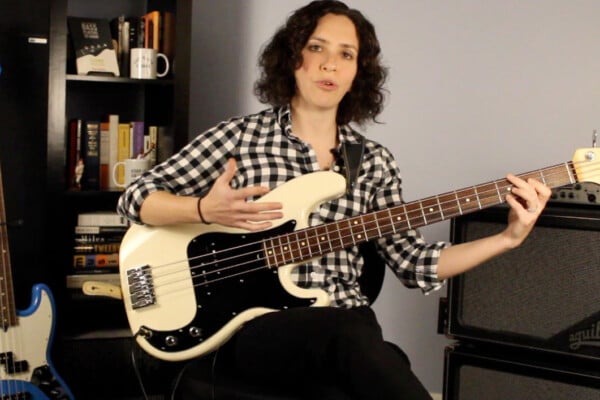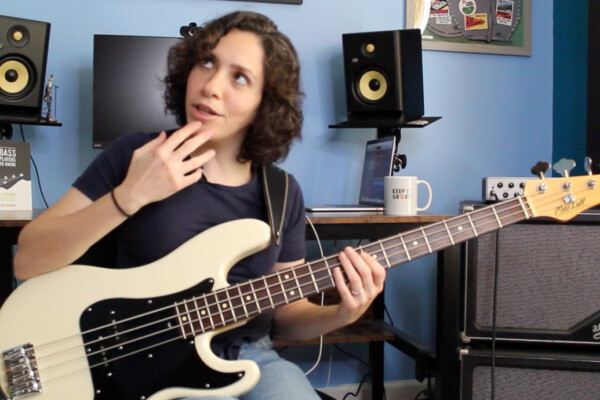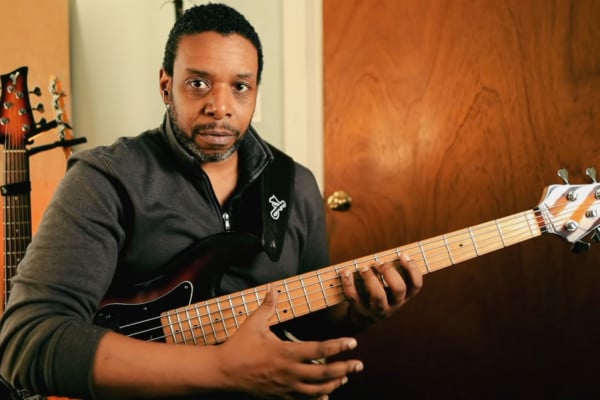Talking Technique: Why Practice Technique?

As musicians, wouldn’t it make sense to focus exclusively on musical applications and learn by practicing mainly songs? Why isolate technique drills and put so much focus on the mechanics, seemingly devoid of any musical context? Why waste an opportunity to build ears and creative skills at the same time and instead reduce practice to apparently mindless, non-creative and non-musical mechanics?
I know that opinions and approaches vary greatly on this topic. My take and what has worked for me – that is what this article is about.
Why I love Technique Drills
I swear by them. They have never seemed mindless at all to me; rather, I see them as an opportunity to practice in a meditative and introspective way. They have given me ideas for musical concepts, aligned my goals and provide a regular, welcome routine. Also, they serve as a fantastic benchmark of progress. And they have allowed me much freedom when improvising or expressing groove ideas; they helped me master pieces I am transcribing; overall, they help me be freer on the instrument.
I have a classical background and started playing piano and other instruments when I was very little. Technique drills have a strong tradition in classical music – just think Hanon or Czerny. Fingering, posture, technique were requirements to master; all these were considered as important as the right notes themselves! Also vital: phrasing, dynamics and feel – all of which require technical skill. So I experienced the value of this training early on and integrated it into my musical life.
Self-trained players may never have done technique drills just for the sake of building good technique. If learning repertoire is front and center, chances are you are tempted to gloss over fingering or posture details; as a result, bad habits can manifest. However: some players with incredible technique, speed, and fluidity in their playing say they never do technical drills. How come they “got it,” then?
Some say they don’t practice technique, but then go on to describe a regimen of drills without really classifying them as technique drills: when running into a speed bump or road block of some kind, they would take it apart and practice it systematically, all over the bass, in variations. I definitely classify that as useful and targeted technique practice.
Here are a few of my favorite reasons to recommend focused technique exercises as part of a well-rounded practice regimen:
Mechanical Effectiveness Versus Musical Effect
Well thought out technique drills focus on very specific aspects of playing that have distinct musical effects: by isolating the mechanics of a certain aspect – like staccato versus legato, for example – you become aware how the mechanics are different between the two – rather than how the musical effect is different. Try, for example, practicing a scale legato versus staccato and pay attention to the difference in mechanics at various tempos.
Once you have the mechanics down, it is much easier to create the desired musical effects. Or, said in another way: the underlying technique not being fluent no longer hinders musical expressiveness.
Not Getting Tired of The Beautiful Music
If you run into a stumbling block when practicing a musical piece, you may want to start repeating that tough passage over and over trying to master an underlying technical challenge. Without, however, taking apart/slowing down/analyzing the mechanics behind the passage systematically, it may be hard to trouble shoot the issue effectively. And also: the danger of getting frustrated with that piece of music (or getting tired of it entirely) is very high.
I do this instead – whenever I run into a passage, run, fill, whatever, that I cannot execute, I will create systematic exercises from the passage. For example, I take a lick, fill or short passage and run it through the Cycle, sequence it through a scale, play it in various ranges of the bass.
Aiding Memorization And Learning in Chunks
I regularly shed scales, permutations, arpeggios etc.; I do this in all areas of the bass. These drills and the materials I practiced then become chunks of information that make memorizing music easier. For example, if I practice common chord changes, the cycle of fifths, the diatonic cycle (see Beautiful Practice in major and minor), arpeggios (Talking Triads), scales (for example The Tetrachord workout, Harmonic Minor Speed Shedding) – these musical elements become easy to recall units of information. I then have already memorized this and can execute the resulting lines with technical proficiency.
A Great Change of Pace
Strange as it may sound, when playing a lot of musical repertoire, practicing technique can be freeing and a welcome change of pace and mind set. When you practice technique, the focus can be on clean execution alone; you don’t need to concern yourself with note choices, musical questions, and expressive interpretation.
You can allow yourself to experiment with technique exercises without concern of how and if this will make any musical sense. From that, new musical ideas can and in my experience often do come (Pivot Permutations in a Blues, Octaves on Overdrive, Drills for Fills and Drills for Fills Applied, Groove Creation Workout, Talking Double Stops).
It works both ways: technique springs musical ideas, whereas musical ideas spark technique exercises.
Technique Skills Develop Discipline And Set The Mood
I like to start each practice session with a technique drill for the main reason that it helps my practice have structure. My technique regimens ease me into focus and get my fingers ready. When I have a gig I may or may not be able to “warm up” – I like to, if it is possible. And if it is, I run a few of my favorite tech drills – and they tend to get me into a focused mood for mind and fingers alike – one that I am used to from my practice sessions.
Confidence Boosting
Developing technique boosts confidence. Consistently working on your technical prowess raises your baseline skill – that’s the level of playing that’s unshakable even on an off day.
A Different Kind of Motivation
I find it very satisfying and motivating to play something only to find out things like: How fast can I do this? How slow can I play this and still play clean and in time? Can I do this all over the instrument? Can I play this with my eyes closed (Jumps without looking at the fretboard, Close Your Eyes And See in New Ways)
Making Sense of Musical Elements
Some music or elements will not make sense if the underlying technique is not understood or not part of one’s repertoire. Have you ever tried playing quarter-tone music, for example? It would certainly require a technical adjustment.
Ever used floating thumb technique? Or right hand three finger technique? How about double thumping or tapping? By practicing these techniques systematically and in isolation you begin to see what is possible and they become accessible to you. It also helps you to understand how players who use these techniques come up with some of their musical ideas (at least in part).
Technical Struggles Interfering With the Music
If the technique is too much of a challenge in a piece of music, we won’t be able to do the music justice. For example, we’d have to play it slower than intended. Nuances would get lost in the struggle. The struggle can be so all-consuming that we have no capacity left to infuse the music with emotion and expression. What the listener will hear is someone chasing the notes and struggling with the instrument. That is just a bummer!
Never Experiencing or Appreciating the Power of Relaxed Playing
Technique practice done right leads to a delicious fluidity. It enables a relaxed type of playing, so you can keep going for hours even as you play speedy heavy metal or a super fast bebop tune. Most importantly, if you relax you open yourself up to the music. Expression and creativity can flow much more freely. And you get to enjoy the whole experience more.
If you have been playing a certain way for years you may not even be aware of the tension that could have been building up – typical spots are neck, left hand thumb, shoulders.
When struggling with a passage, the typical approach often is to add more tension – to try even harder. This can become a frustrating loop to fall into. Targeted technique practice that focuses on letting go of the unnecessary tension brings much relief. This also helps to prevent injury. As a participant of my course happened to write to me yesterday: “Relax! What a concept! Thank you, I have been torturing myself with that bass for years!”
Musical Relevance
Any technique practice – no matter how dry it may seem when looked at in isolation – becomes musically relevant when put in the bigger context of one’s musical path:
- Certain techniques are required elements of styles.
- Some music requires certain tempos;
- Or playing in certain ranges;
- Or certain methods of producing tones – from slapping to finger plucking to using a pick, ebow, or funk fingers;
Technique can be practiced on any basic musical material – try scales, chords, intervals,chromatics. Technique becomes musically relevant when the music you are learning requires the skill trained. In other words: choose technical exercises that train skills needed to perform the music you want to perform.
Musical Sense is Something we Ascribe
The argument that technique exercises have no musical content makes no sense to me: there is no inherent music (or musical sense) in any of the common elements of music – not in intervals, scales, chords, phrasing, and articulation (ways to generate tone). Musical sense comes from what we make of these elements, how we combine them to express ourselves through music. Meaning comes from context (that we create). It comes from what we put into the music.
Practicing arpeggios/scales is not inherently more musical than chromatic permutations or slides between notes or hitting the strings with a pencil (it’s an interesting tone). Any technical element can become a tool for musical expression when put into a context.
Balance
As much as it makes sense to practice with the goal to optimize mechanics, I find it important to practice playing expressively; to feel the music and let it show in the playing. The two aspects need to be in balance. And that said, better technical facility removes barriers from musical expression; only in very rare cases do technical limitations become an expressive tool; such players are typically expressive despite their limitations, not because of them.
I say, do three weeks of regular permutation practice using my PORA technique and then evaluate your finger dexterity. Observe if this “spills over” to other areas of your playing. Just 10 minutes of focused technique practice five times a week will be enough to give you a bench mark. Record yourself before and after. Take note of your current speed, challenges (choppy? fret buzz? uneven tone?) and goals. Evaluate. I am willing to bet that you will find some benefit even within this very simple regimen.
On to new technicals highs – or lows, rather, for us bassists!
Austrian-gone-Californian Ariane Cap is a bassist, educator, blogger and author. In her book Music Theory for the Bass Player and corresponding 20-week online course, she teaches music theory, bass technique, bass line creation and fretboard fitness in a systematic, practical and experiential way. She just released a brand new course on ear training for the bass player: Ear Confidence - 6 Paths to Fearless Ears. Contact her via her blog or website.



